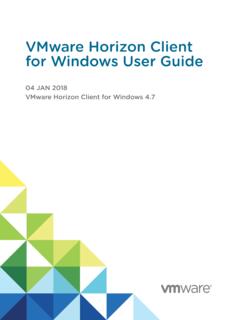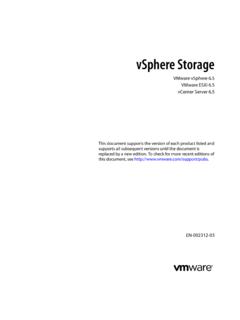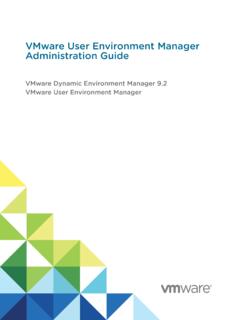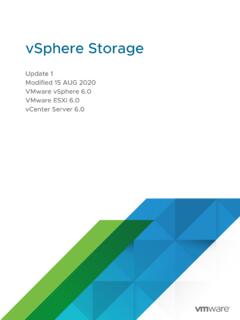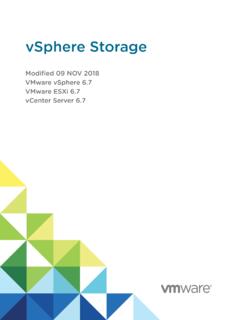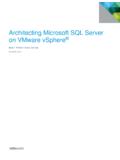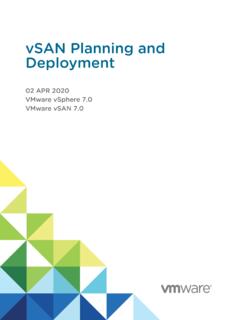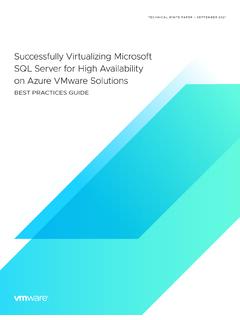Transcription of Deployment vSAN Planning and
1 VSAN Planning and DeploymentUpdate 3 VMware vSphere vSAN can find the most up-to-date technical documentation on the VMware website at: , Hillview Alto, CA 2018-2021 VMware, Inc. All rights reserved. Copyright and trademark Planning and DeploymentVMware, vSAN Planning and Deployment61 Introduction to vSAN7vSAN Concepts7 Characteristics of vSAN8vSAN Terms and Definitions10vSAN and Traditional Storage14 Building a vSAN Cluster15vSAN Deployment Options15 Integrating with Other VMware Software17 Limitations of vSAN182 Requirements for Enabling vSAN19 Hardware Requirements for vSAN19 Cluster Requirements for vSAN21 Software Requirements for vSAN21 Networking Requirements for vSAN22 License Requirements223 Designing and Sizing a vSAN Cluster23 Designing and Sizing vSAN Storage Components23 Planning Capacity in vSAN24 Design Considerations for Flash Caching Devices in
2 VSAN26 Design Considerations for Flash Capacity Devices in vSAN28 Design Considerations for Magnetic Disks in vSAN29 Design Considerations for Storage Controllers in vSAN30 Designing and Sizing vSAN Hosts31 Design Considerations for a vSAN Cluster32 Designing the vSAN Network33 Creating Static Routes for vSAN Networking36 Best Practices for vSAN Networking37 Designing and Sizing vSAN Fault Domains 37 Using Boot Devices and vSAN38 Persistent Logging in a vSAN Cluster394 Preparing a New or Existing Cluster for vSAN40 Selecting or Verifying the Compatibility of Storage Devices40 Preparing Storage41 VMware, Storage Devices41 Mark Flash Devices as Capacity Using ESXCLI 43 Untag Flash Devices Used as Capacity Using ESXCLI44 Mark Flash Devices as Capacity Using RVC45 Providing Memory for vSAN46 Preparing Your Hosts for vSAN46vSAN and vCenter server Compatibility47 Preparing Storage Controllers47 Configuring vSAN Network48 Considerations about the vSAN License495 Creating a vSAN Cluster50 Characteristics of a vSAN Cluster50 Before Creating a vSAN Cluster51 Using Quickstart to Configure and Expand a vSAN Cluster52 Use Quickstart to Configure a vSAN Cluster54 Manually Enabling vSAN56 Set Up a VMkernel Network for vSAN57
3 Create a vSAN Cluster57 Configure a Cluster for vSAN Using the vSphere Client 58 Edit vSAN Settings59 Enable vSAN on an Existing Cluster61 Configure License Settings for a vSAN Cluster63 View vSAN Datastore63 Using vSAN and vSphere HA65 Deploying vSAN with vCenter Server67 Disable vSAN676 Extending a Datastore Across Two Sites with Stretched Clusters69 Introduction to Stretched Clusters 69 Stretched Cluster Design Considerations72 Best Practices for Working with Stretched Clusters73 Stretched Clusters Network Design74 Two-Node vSAN Clusters 75 Use Quickstart to Configure a Stretched Cluster or Two-Node Cluster75 Manually Configure vSAN Stretched Cluster77 Change the Preferred Fault Domain 78 Change the Witness Host78 Deploying a vSAN Witness Appliance79 Set Up the vSAN Network on the Witness Appliance80 Configure Management Network on the Witness Appliance80vSAN Planning and DeploymentVMware, Network Interface for Witness Traffic81 Convert a Stretched Cluster to a Standard vSAN Cluster83 Assign Two-Node Clusters to a Shared Witness Host84 Reassign Shared Witness Host for Two-Node Clusters85vSAN Planning and DeploymentVMware.
4 VSAN Planning and DeploymentvSAN Planning and Deployment describes how to design and deploy a vSAN cluster in a vSphere environment. The information includes system requirements, sizing guidelines, and suggested best VMware, we value inclusion. To foster this principle within our customer, partner, and internal community, we create content using inclusive AudienceThis manual is intended for anyone who wants to design and deploy a vSAN cluster in a VMware vSphere environment. The information in this manual is written for experienced system administrators who are familiar with virtual machine technology and virtual datacenter operations.
5 This manual assumes familiarity with VMware vSphere, including VMware ESXi, vCenter server , and the vSphere more information about vSAN features and how to configure a vSAN cluster, see Administering VMware more information about monitoring a vSAN cluster and fixing problems, see the vSAN Monitoring and Troubleshooting , to vSAN1 VMware vSAN is a distributed layer of software that runs natively as a part of the ESXi hypervisor. vSAN aggregates local or direct-attached capacity devices of a host cluster and creates a single storage pool shared across all hosts in the vSAN supporting VMware features that require shared storage, such as HA, vMotion, and DRS, vSAN eliminates the need for external shared storage and simplifies storage configuration and virtual machine provisioning chapter includes the following topics.
6 NvSAN ConceptsnvSAN Terms and DefinitionsnvSAN and Traditional StoragenBuilding a vSAN ClusternvSAN Deployment OptionsnIntegrating with Other VMware SoftwarenLimitations of vSANvSAN ConceptsVMware vSAN uses a software-defined approach that creates shared storage for virtual machines. It virtualizes the local physical storage resources of ESXi hosts and turns them into pools of storage that can be divided and assigned to virtual machines and applications according to their quality-of-service requirements. vSAN is implemented directly in the ESXi can configure vSAN to work as either a hybrid or all-flash cluster. In hybrid clusters, flash devices are used for the cache layer and magnetic disks are used for the storage capacity layer.
7 In all-flash clusters, flash devices are used for both cache and can activate vSAN on your existing host clusters and when you create new clusters. vSAN aggregates all local capacity devices into a single datastore shared by all hosts in the vSAN cluster. You can expand the datastore by adding capacity devices or hosts with capacity devices to the cluster. vSAN works best when all ESXi hosts in the cluster share similar or identical VMware, across all cluster members, including similar or identical storage configurations. This consistent configuration balances virtual machine storage components across all devices and hosts in the cluster.
8 Hosts without any local devices also can participate and run their virtual machines on the vSAN a host contributes its local storage devices to the vSAN datastore, it must provide at least one device for flash cache and at least one device for capacity. Capacity devices are also called data devices on the contributing host form one or more disk groups. Each disk group contains one flash cache device, and one or multiple capacity devices for persistent storage. Each host can be configured to use multiple disk best practices, capacity considerations, and general recommendations about designing and sizing a vSAN cluster, see the VMware vSAN Design and Sizing of vSANThis topic summarizes characteristics that apply to vSAN, its clusters, and provides numerous benefits to your 1-1.
9 VSAN FeaturesSupported FeaturesDescriptionShared storage supportvSAN supports VMware features that require shared storage, such as HA, vMotion, and DRS. For example, if a host becomes overloaded, DRS can migrate virtual machines to other hosts in the formatvSAN on-disk virtual file format provides highly scalable snapshot and clone management support per vSAN cluster. For information about the number of virtual machine snapshots and clones supported per vSAN cluster, see the Configuration Maximums and hybrid configurationsvSAN can be configured for all-flash or hybrid domainsvSAN supports configuring fault domains to protect hosts from rack or chassis failures when the vSAN cluster spans across multiple racks or blade server chassis in a data target servicevSAN iSCSI target service enables hosts and physical workloads that reside outside the vSAN cluster to access the vSAN clustervSAN supports stretched clusters that span across two geographic Planning and DeploymentVMware.
10 1-1. vSAN Features (continued)Supported FeaturesDescriptionSupport for Windows server Failover Clusters (WSFC)vSAN Update 3 and later releases support SCSI-3 Persistent Reservations (SCSI3-PR) on a virtual disk level required by Windows server Failover Cluster (WSFC) to arbitrate an access to a shared disk between nodes. Support of SCSI-3 PRs enables configuration of WSFC with a disk resource shared between VMs natively on vSAN the following configurations are supported:nUp to 6 application nodes per to 64 shared virtual disks per Microsoft SQL server 2012 or later running on Microsoft Windows server 2012 or later has been qualified on health servicevSAN health service includes preconfigured health check tests to monitor, troubleshoot, diagnose the cause of cluster component problems, and identify any potential performance servicevSAN performance service includes statistical charts used to monitor IOPS, throughput, latency, and congestion.
